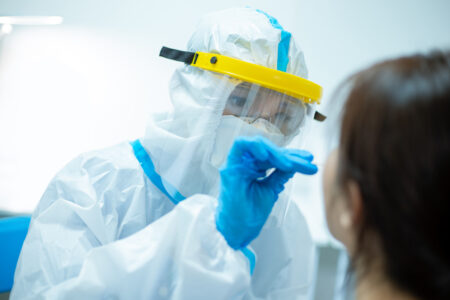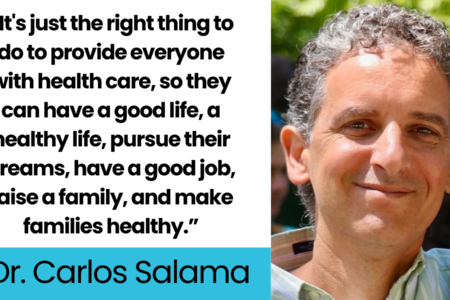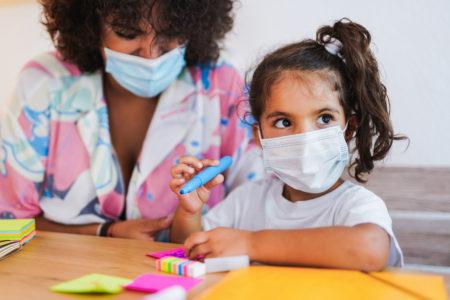
Share On Social!
Respirators are a common type of personal protective equipment (PPE) – but not the only one.
Gowns, gloves, goggles, and face shields are other kinds of PPE that Latino and all frontline healthcare workers use to help the spread of germs and viruses, including the virus that causes COVID-19.
Gowns
In healthcare, gowns are worn over your work clothes to reduce transmission of germs. They make it easier to remove germs and body fluids that might get on you while you work.
“Germs that get on your clothes can spread to you. But they can also spread to other surfaces and other people,” said Dr. Abigail Carlson, an infectious diseases physician with the Centers for Disease Control & Prevention (CDC), as part of CDC Project Firstline’s Inside Infection Control video series. “Gowns are there to keep the stuff off of your clothes, so that you don’t have to change clothes every time something gets on you at work.”
Removing and disposing of your gown properly can keep germs from spreading in the environment.
Make sure to remove your gown when it gets dirty, and before moving to the next patient or the next task.
To remove your gown, roll it inward into itself as you take it off to ensure the dirt and germs on the outside are contained and thrown away with the gown – either into the trash if it’s disposable, or the laundry bin if it’s reusable.
You might find that you need to change your gown in the middle of a task. Do it as soon as it’s safe to stop and change.
“If you can’t do it right away, wait until it’s safe. But as soon as you’re able to, get that new gown as soon as you can, so that you can prevent spread of things on your gown onto other surfaces in the room,” Dr. Carlson said. “It is important to try not to touch surfaces as you’re moving around with your gown. Any of us who have tried to work our way through a small patient room knows that is a challenge. It is not going to be perfect; but pay attention to it so that you avoid spreading germs as best you can.”
You should wear a gown that isn’t too small so that you can’t move freely, or so big that it drags on the floor or creates a trip hazard.
Wearing more than one gown at the same time doesn’t give you more protection against germs.
CDC does not recommend wearing more than one gown at a time. The extra layers can get in your way, and when you remove the top gown, you can accidentally contaminate the bottom gown.
Gloves
Using gloves also makes it easier to remove germs that may get on you while you work.
Because we use our hands to perform many tasks, gloves can help you avoid spreading germs in your work environment and to patients and coworkers.
Gloves also prevent germs from entering your body through breaks in the skin on your hands, like cuts and wounds, and infecting you and anyone you touch.
“Healthy skin is a fantastic barrier to infection. If you touch something in your daily life, most of the time nothing happens,” Dr. Carlson said. “But if you have small cracks or wounds or breaks in your skin, germs can get through those and then it can make you sick or cause problems with your skin.”
Removing gloves at the right time is important. Germs can spread to other places and people in your facility if you go from place to place wearing the same pair of gloves.
When you move from one patient or one task to another, make sure to take off and throw away your used gloves, clean your hands, and if needed, put on clean gloves to prevent spreading germs.
To protect yourself and others, always clean your hands right away after you remove your gloves. This step is important because even when you remove your gloves correctly, you can get germs on your hands. Cleaning your hands keeps you from accidentally spreading germs to other people and the environment you work in.
Additionally, you should clean your hands before you reach for new gloves so that your dirty hands don’t contaminate all the gloves in the box.
“Any of us who have worked in healthcare, we know that when you put your hand into that box, it’s not as simple as just pulling out one glove. You have to pull that glove apart from all the other gloves in the box, and that means you’re handling all the gloves in the box,” Dr. Carlson said.
“Double-gloving,” or wearing more than one pair of gloves at a time, is not recommended for routine care.
When you wear more than one pair of gloves during patient care, removing and replacing the top layer of gloves between patients increases your risk of contaminating the bottom pair of gloves and spreading germs to yourself, others, and the environment.
Wearing more than one pair of gloves can also make it harder to move your hands and fingers while providing care, which can lead to mistakes.
Goggles and Face Shields
Most of the time, your tears and a thin lining layer called the conjunctiva are enough to do a great job of protecting your eyes.
But for COVID-19, we want to give our eyes the extra protection of goggles or face shields.
Both goggles and face shields are recommended for COVID-19 because the respiratory droplets that carry the virus can get into the lining of our eyes and make us sick.
“Respiratory droplets with the virus in them can hit this eye system, mix with the liquid in the eyes, travel down those drains and into the nose and the back of the throat,” Dr. Carlson said. “When the virus gets to those places – the nose, throat, and mouth – it can find cells that it can hack into and cause infection.”
When wearing eye protection, make sure it doesn’t get in the way of your other PPE, and that you can see what you’re doing.
If your vision is blocked, you can be injured and you might injure someone near you.
What Can You Do to Promote Infection Control in Your Healthcare Setting?
Access more information about infection prevention and control in healthcare by visiting resources from CDC Project Firstline.
Project Firstline creates resources, including videos and shareable images, web buttons, posters, and print materials. They also have facilitator toolkits to help workers lead trainings even if they are not an infection control expert.
Salud America! at UT Health San Antonio is working with the National Hispanic Medical Association to bring Project Firstline infection control educational content to healthcare workers, so they are equipped with the knowledge they need to protect themselves, their facilities, and their patients (Latinos and all communities) from infectious disease threats in healthcare settings.
You can read these articles:
- What is Project Firstline?
- What’s a Virus?
- How Does Infection Control Work on COVID-19 Variants Like Omicron?
- Contact Time: What is It and How Does it Impact Infection Control?
- The Surprising Difference Between Cleaning and Disinfection
- What’s a Respiratory Droplet and Why Does It Matter?
- Why Do Cleaning and Disinfection Matter in Healthcare?
- We Need to Talk about Hand Hygiene Again
- What is the Goal of Infection Prevention and Control in Healthcare Settings?
- The Intersection of Infection Prevention and Control and Healthcare Equity
- N95 Respirators: Everything You Need to Know
- How Do I Safely Use a Multi-Dose Vaccine Vial?
“Healthcare teams in hospitals, nursing homes, and other care settings are the front lines against the spread of infection,” said Dr. Amelie G. Ramirez, director of Salud America! at UT Health San Antonio. “CDC’s Project Firstline is bolstering those efforts by developing evidence-based tools that can be delivered in a variety of ways to make infection control learning convenient and accessible for busy healthcare staff.”
LEARN MORE ABOUT PROJECT FIRSTLINE!
Editor’s Note: This article is part of a collaboration between Salud America!, the National Hispanic Medical Association, and the CDC’s Project Firstline. To find resources training materials, and other tools to bolster knowledge and practice of infection control, visit Project Firstline and view Salud America!’s infection control content.
By The Numbers
142
Percent
Expected rise in Latino cancer cases in coming years




[…] The pandemic is another chapter in the bitter story of American racism and inequality. Black and Latinx people are being infected and are dying at much higher rates than white Americans. Many people of […]
[…] coronavirus has killed over 61,000 Latinos in America according to the CDC, accounting for over 18.2% of the total COVID deaths in the […]
[…] Whereas Hispanics make up 11% of D.C.’s inhabitants, they signify 19% of the COVID cases, and 14% of the deaths. Equally, 46% of D.C.’s residents are Black, they usually make up an alarming 75% […]
[…] and historical mistreatment. According to the U.S. Centers for Disease Control and Prevention, Latino and Black American communities are three times more likely to become infected with […]
[…] Covid pandemic has hit the Latino community particularly hard, and data from the nonprofit health equity advocacy group Salud America! shows Latinos lead in the 0-24 age […]
[…] the pandemic, Latinos took major blows, both in terms of COVID-19 cases and also from the economic recession under former President Donald Trump. Nearly half (49%) of […]
[…] the positive trend, the harm may have already been done. The pandemic has disproportionately impacted Latino communities. Reuters reported that election-related or political disinformation that […]
[…] pesar de la tendencia positiva, es posible que el daño ya esté hecho. La pandemia ha impactado desproporcionadamente Comunidades latinas. Reuters informó que la desinformación política o relacionada con las […]
[…] residentes blancos muestran una tasa mucho más baja con 10 muertes por cada 100,000 habitantes(8 9) . Los afroestadounidenses por su parte, denuncian subsistemas de salud que les segregan […]
[…] https://salud-america.org/coronavirus-case-rates-and-death-rates-for-latinos-in-the-united-states/ […]
[…] https://salud-america.org/coronavirus-case-rates-and-death-rates-for-latinos-in-the-united-states/ […]
[…] communities have the second-highest number of COVID-19 cases in the U.S. They’re also more likely to become hospitalized and die from the disease than other […]
[…] total, around 160,000 Latinos were killed by COVID-19. This accounts for 16% of the 1 million deaths in the country. The […]